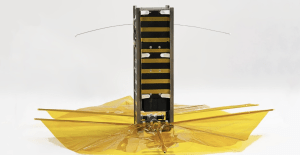 Read the full story on Brown News.
Read the full story on Brown News.
PROVIDENCE, R.I. [Brown University] — Common sense suggests that space missions can only happen with multimillion-dollar budgets, materials built to withstand the unforgiving conditions beyond Earth’s atmosphere, and as a result of work done by highly trained specialists.
But a team of engineering students from Brown University has turned that assumption on its head.
They built a satellite on a shoestring budget and using off-the-shelf supplies available at most hardware stores. They even sent the satellite — which is powered by 48 Energizer AA batteries and a $20 microprocessor popular with robot hobbyists — into space about 10 months ago, hitching a ride on Elon Musk’s SpaceX rocket.
Now, a new analysis of data from Air Force Space Command shows that the satellite not only successfully operated, but could have far-ranging impacts on efforts to cut down on the growing problem of space debris, which poses a potential danger to all current and future space vehicles.
According to NASA, there are now more than 27,000 pieces of what it calls orbital debris or space junk being tracked by the Department of Defense’s global Space Surveillance Network. Orbital debris ranges from any human-made object in Earth’s orbit that no longer serves a useful function, like nonfunctional spacecraft, abandoned launch-stage vehicles, mission-related debris and fragmentation debris. It also includes defunct satellites that remain in orbit sometimes decades after their mission is complete.
That’s a problem, given that most satellites remain in orbit for an average of 25 years or more, said Rick Fleeter, an adjunct associate professor of engineering at Brown. So when his students got a once-in-a-lifetime chance to design and build their own satellite to be launched into space, they decided to engineer a potential solution.
The students added a 3D-printed drag sail made from Kapton polyimide film to the bread-loaf-sized cube satellite they built. Upon deployment at about 520 kilometers — well above the orbit of the International Space Station — the sail popped open like an umbrella and is helping to push the satellite back down to Earth sooner, according to initial data. In fact, the satellite is well below the other small devices that deployed with it. In early March, for instance, the satellite was at about 470 kilometers above the Earth while the other objects were still in orbit at about 500 kilometers or more.
“You can see in the tracking data that we’re visibly below everybody else and accelerating away from them,” Fleeter said. “You can see that our satellite is already descending toward reentry, whereas the others are still in a nice circular orbit higher up.” Read More.
